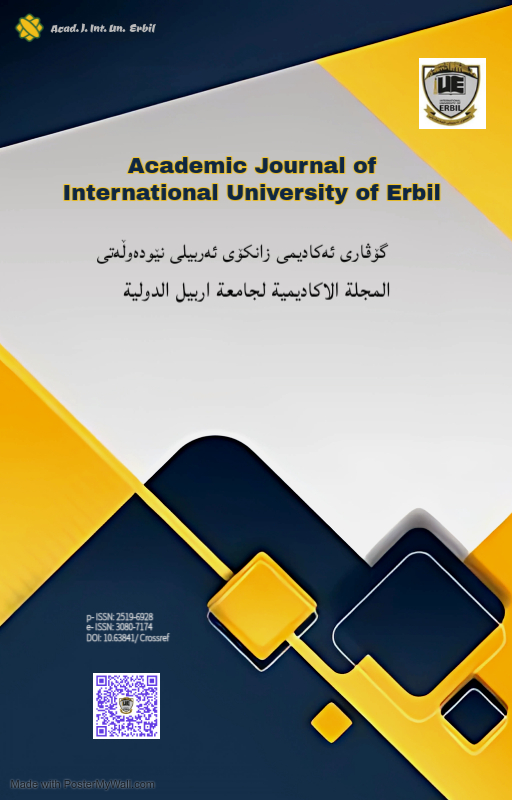Advancements in Facial Recognition Technology for Early Detection of Down Syndrome in Children
Facial Recognition Technology for Early Detection of Down Syndrome
DOI:
https://doi.org/10.63841/iue23593Keywords:
"Artificial Intelligence" "Face Recognition" " Yollov8"Abstract
Artificial intelligence and facial recognition have opened new avenues for early detection of even genetic conditions. This research paper applies a state-of-the-art object detection model, YOLOv8, to accurately identify children with Down syndrome from their faces. The model is then trained and fine-tuned on the face image dataset for high-performance metrics not seen earlier, using the real-time detection capability of YOLOv8.
The model was precision at 0.958 and had a high recall at 0.967. That means that the model will mostly correctly identify all children with Down syndrome while keeping the false positives and false negatives to the minimum. Also, the mean Average Precision of the model is 0.988 out of 1.00 on the IoU threshold of 0.50, mAP50, showing near-perfect overlap between predicted and actual face regions. The model also maintained high performance at 0.746 mAP50-95, which informs the model's ability to make more accurate predictions over the stricter IoU thresholds.
These findings suggest that YOLOv8 may be employed for effective early screening for Down syndrome, offering healthcare providers a non-invasive and efficient solution. More robust detection performance about relevant facial features indicative of the condition will support early diagnosis and, therefore, timely interventions that will significantly enhance the quality of life in children affected with Down syndrome.
This study is probably the most noninvasive, inexpensive screening method for Down syndrome in the world. Its availability can help the least developed parts of the world intervene as early as possible and improve the outcomes for children worldwide, especially those from the most deprived areas.
References
M. E. Weijerman, & J. P. De Winter, “Clinical practice: The care of children with Down syndrome,” European journal of pediatrics, vol.169, pp.1445-1452, 2010.
D. J. Fidler, & L. Nadel, “Education and children with Down syndrome: Neuroscience, development, and intervention,” Mental retardation and developmental disabilities research reviews, vol.13, no.3, pp. 262-271, 2007.
M. J. Bull, T. Trotter, S. L. Santoro, C. Christensen, R. W. Grout, “Health Supervision for Children and Adolescents with Down Syndrome,” Pediatrics, vol. 149, no. 5, pp. e2022057010, 2022, doi.org/10.1542/peds.2022-057010.
J. Qiang, D. Wu, H. Du, H., Zhu, S. Chen, & H. Pan, “Review on facial-recognition-based applications in disease diagnosis,” Bioengineering, vol. 9, no. 7, pp.273,2022.
Z. A. Kakarash, D. F. Abd, M. Al-Ani, G. A. Omar, & K. Mohammed,“Biometric Iris recognition approach based on filtering techniques,” Journal of Garmian University, vol.6, no.2, pp.360-368, 2019.
A. K. Jain, & S. Z. Li, “Handbook of face recognition,” vol.1, p. 699. New York, springer, 2011.
G. A. Omar, Z. K. Othman, & Z. A. Kakarash,“ The transformative impact of artificial intelligence (AI) on enhancing healthcare systems in the Middle East,” Academic Journal of International University of Erbil, vol.1, no.2, pp.1-16. 2024.
O. Agbolade, A. Nazri, R. Yaakob, A. A. Ghani, & Y. K. Cheah, “Down syndrome face recognition: a review,” Symmetry, vol.12, no.7, pp.1182, 2020.
Y. Tang, T. Gao, L. Gao, D. Liu, Z. Li, R. Zhong, K. & Hu, “The Application of Artificial Intelligence-Based Facial Recognition Technology in the Medical Field: Bibliometric Analysis,”2024, Available at SSRN 4903326, https://papers.ssrn.com/sol3/papers.cfm?abstract_id=4903326.
G. Wang, Y. Chen, P. An, H. Hong, J. Hu, & T. Huang, “UAV-YOLOv8: A small-object-detection model based on improved YOLOv8 for UAV aerial photography scenarios,” Sensors, vol.23, no.16, pp.7190, 2023.
M. Sohan, T. Sai Ram, R. Reddy, & C. Venkata, C., “A review on yolov8 and its advancements,” In International Conference on Data Intelligence and Cognitive Informatics (pp. 529-545). Springer, Singapore, 2024.
A. Asim, A. Kumar, S. Muthuswamy, S. Jain, & S. Agarwal, “Down syndrome: an insight of the disease,” Journal of biomedical science, vol. 22, pp.1-9, 2015.
I. Ahmed, T. Ghafoor, N. A. Samore, & M. N. Chattha, “Down syndrome: clinical and cytogenetic analysis, “Journal-College of Physicians and Surgeons of Pakistan, vol.15, no.7, pp.426-429, 2005.
J. Gupta, S. Pathak, & G. Kumar, “Deep learning (CNN) and transfer learning: a review,” In Journal of Physics: Conference Series (vol. 2273, no. 1, p. 012029), IOP Publishing, 2022.
X. Zhou, & T. C. Zhu, “Survey of Research on Face Recognition Methods Based on Depth Learning,” In Journal of Physics: Conference Series (vol. 2717, no. 1, p. 012027). IOP Publishing, 2024.
L. Li, X. Mu, S. Li, & H. Peng, H., “A review of face recognition technology,” IEEE access, vol.8, pp.139110-139120, 2020.
I. Adjabi, A. Ouahabi, A. Benzaoui, & A. Taleb-Ahmed, “Past, present, and future of face recognition: A review,” Electronics, vol.9, no.8, pp.1188, 2020.
P.Jiang, D. Ergu, F. Liu, Y. Cai, & B. Ma, “A Review of Yolo algorithm developments,” Procedia computer science, vol.199, pp.1066-1073, 2022.
T. Diwan, G. Anirudh, & J. V. Tembhurne, “Object detection using YOLO: Challenges, architectural successors, datasets and applications,” Multimedia Tools and Applications, vol.82, no.6, pp.9243-9275, 2023.
J. Du, “Understanding of object detection based on CNN family and YOLO,” In Journal of Physics: Conference Series (vol. 1004, p. 012029). IOP Publishing, 2018.
S. Shinde, A. Kothari, & V. Gupta, “YOLO based human action recognition and localization,” Procedia Computer Science, vol.133, 831-838, 2018.
S. C. Medaramatla, C. V. Samhitha, S. D. Pande, & S. R. Vinta, “Detection of Hand Bone Fractures in X-ray Images using Hybrid YOLO NAS,” IEEE Access, vol.12, pp. 57661-57673, 2024.
Vinayaa1, “Down Syndrome Detection Dataset [Data set],” GitHub. https://github.com/vinayaa1/down-syndrome-detection/tree/main/Dataset, 2025.
A. S. A. Al-slemani, & G. Abubakr, G. “Adaptive Landmine Detection and Recognition in Complex Environments using YOLOv8 Architectures,” Journal of Smart Systems Research, vol.5, no.2, pp.110-120, 2024.
Z. Bao, “ The UAV Target Detection Algorithm Based on Improved YOLO V8,” In Proceedings of the International Conference on Image Processing, Machine Learning and Pattern Recognition, pp. 264-269, 2024.
B. Xiao, M. Nguyen, & W. Q. Yan, W. Q., “Fruit ripeness identification using YOLOv8 model,” Multimedia Tools and Applications, vol.83, no.9, pp.28039-28056, 2024.
G. Yao, S. Zhu, L. Zhang, & M. Qi, M., “HP-YOLOv8: High-Precision Small Object Detection Algorithm for Remote Sensing Images,” Sensors, vol.24, no.15, pp.4858, 2024. https://doi.org/10.3390/s24154858.
A. S. A. Al-slemani, & A. Zengin, “A New Surveillance and Security Alert System Based on Real-Time Motion Detection,” Journal of Smart Systems Research, vol.4, no.1, pp.31-47, 2023. https://doi.org/10.58769/joinssr.1262853.
Q. Zhao, K. Rosenbaum, K. Okada, D. J. Zand, R. Sze, M. Summar, & M. G. Linguraru, M. G, “Automated down syndrome detection using facial photographs,” In 35th Annual International Conference of the IEEE Engineering in Medicine and Biology Society (EMBC) (pp. 3670-3673), 2013.
N. Paredes, E. Caicedo-Bravo, and B. Bacca, “Emotion recognition in individuals with down syndrome: A convolutional neural network-based algorithm proposal,” Symmetry, vol. 15, no. 7, pp. 1435, 2023,
B. Qin, L. Liang, J. Wu, Q. Quan, Z. Wang, & D. Li, “Automatic identification of down syndrome using facial images with deep convolutional neural network,” Diagnostics, vol.10, no.7, pp.487, 2020.
Downloads
Published
Issue
Section
License
Copyright (c) 2025 Academic Journal of International University of Erbil

This work is licensed under a Creative Commons Attribution-NonCommercial-NoDerivatives 4.0 International License.












